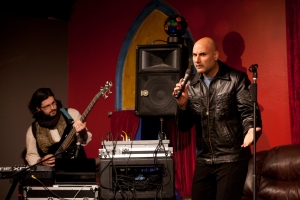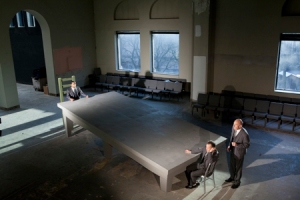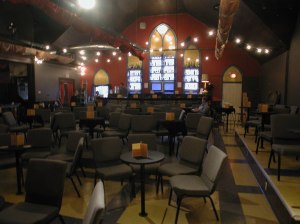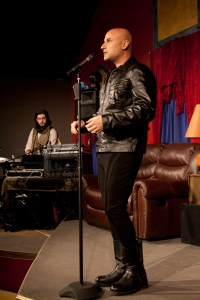by Brandon Getz
 Brahman/i is a play about the spaces in between. Conflicting identities, transformations, trying on different skins until one finally feels like it fits. A play about the process of becoming, and an acknowledgement that that, more than anything, is what life is: the process, not the endgame. To become the title character of Quantum Theatre’s latest production, New York-based actor Sanjiv Jhaveri has to inhabit those between-spaces. It’s challenging, and Sanjiv is bringing his A game.
Brahman/i is a play about the spaces in between. Conflicting identities, transformations, trying on different skins until one finally feels like it fits. A play about the process of becoming, and an acknowledgement that that, more than anything, is what life is: the process, not the endgame. To become the title character of Quantum Theatre’s latest production, New York-based actor Sanjiv Jhaveri has to inhabit those between-spaces. It’s challenging, and Sanjiv is bringing his A game.
“[Brahman/i is] intense. In your face. Mercurial. That’s a word Shishir [Kurup, the director] would also use,” Sanjiv says. “He/she is very much a human being, in terms of the comedy and the showmanship—parts of the show are about covering up pain.”
The play balances on a ledge. It’s got the character’s pain, heartbreak, confusion and loneliness underneath, but ultimately—truly—it’s a comedy. It’s right there in the subtitle that playwright Aditi Brennan Kapil gave her play: “A One-Hijra Stand-Up Comedy Show.” Her note in the script reads, “This play is intended to be a stand-up comedy routine, until it’s not….”
 Sanjiv admits: “I would consider myself a funny person, blah blah blah, but I’m not a stand-up comic.” Not that the actor is a stranger to comedy. Sanjiv has been playing “character” roles since forever. “I’ve been a character actor my whole life. Theatrically speaking, [I started] early in my career letting my body become different characters, and then in the last few years I’ve been doing audio books and giving these different voices to those.
Sanjiv admits: “I would consider myself a funny person, blah blah blah, but I’m not a stand-up comic.” Not that the actor is a stranger to comedy. Sanjiv has been playing “character” roles since forever. “I’ve been a character actor my whole life. Theatrically speaking, [I started] early in my career letting my body become different characters, and then in the last few years I’ve been doing audio books and giving these different voices to those.
It was this experience in character acting that landed Sanjiv his starring role in Brahman/i. A few years ago, during a South Asian Theatre Festival here in Pittsburgh, the actor performed the part of the clown character in a staged reading of Shishir Kurup’s Merchant on Venice, a present-day Indian-American adaptation of the Shakespearean classic. “Shishir and I go way back. I was in a play of his fifteen years ago: On Caring for the Beast. The work that he’s done as a playwright is outstanding—he’s written the bulk of it in iambic pentameter.”
 Quantum founder and artistic director Karla Boos presented the reading as part of that festival and, two years later, recruited Sanjiv Jhaveri and Shishir Kurup to take on Brahman/i, part one of Kapil’s Displaced Hindu Gods trilogy. After reading the script, in which 95% of the lines belong to Brahman/i, Sanjiv thought, “Wow, this is going to be a massive challenge. But if I can get out of my own way, I can do something special with this.”
Quantum founder and artistic director Karla Boos presented the reading as part of that festival and, two years later, recruited Sanjiv Jhaveri and Shishir Kurup to take on Brahman/i, part one of Kapil’s Displaced Hindu Gods trilogy. After reading the script, in which 95% of the lines belong to Brahman/i, Sanjiv thought, “Wow, this is going to be a massive challenge. But if I can get out of my own way, I can do something special with this.”
To do that, Sanjiv was off book on the first day of rehearsal. “We read the play, and then I got up on my feet and started moving. That doesn’t usually happen.” Having the lines already committed to memory, Sanjiv could focus on comedic timing, on delivery, and on inhabiting the multitude of other characters—a know-it-all aunt, an apathetic cousin—that Brahman/i works into the comedy routine.
To become Brahman/i, Sanjiv has had to explore the gender fluidity of the character. It isn’t drag, and it pushes beyond the male/female binaries we often take for granted. “I bought some nail polish the other day,” the actor says. Onstage, “I want to make sure I don’t chip my nail polish, and that affects my physicality in a certain way. That’s something Brahman/i is commenting on—here are these roles we take on as men and as women, and what is that? Are there more options than that?”
 “I have always felt like I’ve had a male spirit and a female spirit inside me, so there were things that weren’t totally new for me,” says Sanjiv. “But then there were things that were—like the nail polish.”
“I have always felt like I’ve had a male spirit and a female spirit inside me, so there were things that weren’t totally new for me,” says Sanjiv. “But then there were things that were—like the nail polish.”
As opening night nears, Sanjiv has risen to the challenge. The performance is intense, but it isn’t grueling—the actor is having a blast onstage. “The most fun has just been seeing how ridiculous my mind can be when I allow myself to be completely open, in terms of delivering a line or becoming a character. You have to let yourself be open to the ridiculosity.”
See Sanjiv Jhaveri become Brahman/i in Quantum Theatre’s production of Brahman/i, directed by Shishir Kurup, playing at the Temple of Comedy, 113 N. Pacific Avenue, January 30 through February 22. Purchase TICKETS online or call 412-362-1713
Brandon Getz is a writer and blogger living in Pittsburgh. Read more at brandongetz.com
(photos by Heather Mull)
 We hope your experience at Quantum’s All the Names was a good one. Our staff and board are interested to hear what you think, and encourage you to talk with others as well, so we have initiated an online conversation you can join with fellow attendees. What did you like/dislike about the production? Was there something in particular that resonated with you? Something particularly confusing? Any comments or suggestions are greatly encouraged.
We hope your experience at Quantum’s All the Names was a good one. Our staff and board are interested to hear what you think, and encourage you to talk with others as well, so we have initiated an online conversation you can join with fellow attendees. What did you like/dislike about the production? Was there something in particular that resonated with you? Something particularly confusing? Any comments or suggestions are greatly encouraged.
 Step into the shoes of Senhor José in Quantum Theatre’s world premiere of All The Names, devised by Karla Boos, Chris Evans, Cindy Limauro, Barbara Luderowski, Sarah Pickett, Megan Monaghan Rivas, Joe Seamans, and Narelle Sissons. The show opens April 10 and runs through May 2 at the Original Carnegie Free Library in Allegheny Commons, adjacent to the New Hazlett Theater. Purchase TICKETS
Step into the shoes of Senhor José in Quantum Theatre’s world premiere of All The Names, devised by Karla Boos, Chris Evans, Cindy Limauro, Barbara Luderowski, Sarah Pickett, Megan Monaghan Rivas, Joe Seamans, and Narelle Sissons. The show opens April 10 and runs through May 2 at the Original Carnegie Free Library in Allegheny Commons, adjacent to the New Hazlett Theater. Purchase TICKETS 
 The space could not be more perfect. One of the country’s oldest library buildings, the Carnegie Free Library, which sits in the Allegheny Commons area of Pittsburgh’s North Side neighborhood, was once a bustling cultural center. Seeing its patronage diminish as Allegheny City’s population fell and resources were diverted to other branches, the library closed after lightning hit the clock tower in 2006, its once-hallowed halls stripped of books and shelving and the card indexes of a century of history. But, at least for the run of All The Names, the ghosts of the stacks are back, stocked with the Central Registry’s records of Births, Marriages, and Deaths: the primary data of everyone in Saramago’s unnamed country; stocked, essentially, with all the names.
The space could not be more perfect. One of the country’s oldest library buildings, the Carnegie Free Library, which sits in the Allegheny Commons area of Pittsburgh’s North Side neighborhood, was once a bustling cultural center. Seeing its patronage diminish as Allegheny City’s population fell and resources were diverted to other branches, the library closed after lightning hit the clock tower in 2006, its once-hallowed halls stripped of books and shelving and the card indexes of a century of history. But, at least for the run of All The Names, the ghosts of the stacks are back, stocked with the Central Registry’s records of Births, Marriages, and Deaths: the primary data of everyone in Saramago’s unnamed country; stocked, essentially, with all the names. “Carnegie, when he had these things designed, he designed them for multiple uses,” says John Canning, vice president of the Allegheny City Society, a historical group dedicated to the legacy of North Side landmarks. “They often had music halls, lecture halls. They weren’t just libraries.”
“Carnegie, when he had these things designed, he designed them for multiple uses,” says John Canning, vice president of the Allegheny City Society, a historical group dedicated to the legacy of North Side landmarks. “They often had music halls, lecture halls. They weren’t just libraries.” Boos has been co-adapting the production with Mattress Factory founder Barbara Luderowski and a host of “co-devisers,” artists and designers who’ve not so much transformed the library as restored it, at least a version of itself, a version that feels at once fantastically overwhelming—the labyrinthine world of the Central Registry—while throwing the absences in the space into stark relief: you become acutely aware that this beautiful place once housed real books.
Boos has been co-adapting the production with Mattress Factory founder Barbara Luderowski and a host of “co-devisers,” artists and designers who’ve not so much transformed the library as restored it, at least a version of itself, a version that feels at once fantastically overwhelming—the labyrinthine world of the Central Registry—while throwing the absences in the space into stark relief: you become acutely aware that this beautiful place once housed real books.




 Brahman/i is a play about the spaces in between. Conflicting identities, transformations, trying on different skins until one finally feels like it fits. A play about the process of becoming, and an acknowledgement that that, more than anything, is what life is: the process, not the endgame. To become the title character of Quantum Theatre’s latest production, New York-based actor Sanjiv Jhaveri has to inhabit those between-spaces. It’s challenging, and Sanjiv is bringing his A game.
Brahman/i is a play about the spaces in between. Conflicting identities, transformations, trying on different skins until one finally feels like it fits. A play about the process of becoming, and an acknowledgement that that, more than anything, is what life is: the process, not the endgame. To become the title character of Quantum Theatre’s latest production, New York-based actor Sanjiv Jhaveri has to inhabit those between-spaces. It’s challenging, and Sanjiv is bringing his A game.





 “We didn’t set out to be in a former church,” says Karla Boos, Quantum Theatre’s founder and artistic director. “But what could be better than a former church, a ‘transitioned’ place of spirituality. And we started riffing: it’s the Temple of Comedy. The ‘marquee’ outside is a church sign, with rotating jokes like the sermon announcements.”
“We didn’t set out to be in a former church,” says Karla Boos, Quantum Theatre’s founder and artistic director. “But what could be better than a former church, a ‘transitioned’ place of spirituality. And we started riffing: it’s the Temple of Comedy. The ‘marquee’ outside is a church sign, with rotating jokes like the sermon announcements.”
 But Mauk isn’t just creating a comedy club. There’s an invisible element at work in the design, an element you’ll feel as you enter. “No one should feel like an outsider in this space,” he says. “They should feel at home and entertained or intrigued by their surroundings. So much about the piece is just accepting someone as they are, how they feel in that moment,” and the club Mauk is building sets out to offer that same feeling of acceptance, where everyone, even someone like Brahman/i, can feel at home.
But Mauk isn’t just creating a comedy club. There’s an invisible element at work in the design, an element you’ll feel as you enter. “No one should feel like an outsider in this space,” he says. “They should feel at home and entertained or intrigued by their surroundings. So much about the piece is just accepting someone as they are, how they feel in that moment,” and the club Mauk is building sets out to offer that same feeling of acceptance, where everyone, even someone like Brahman/i, can feel at home.

 With Quantum Theatre, your experience is never the same twice. That goes double with John Shepard’s production of Tamara: not only can you follow a different character each time you see the show, you will also find a new menu—and a new wine—available each week of the run. With Tamara, Quantum not only dives into new territory with an immersive theatre experience, but also into providing both the dinner and the show: your whole night out, brought to you by Quantum Theatre and the amazing chefs of six great local restaurants.
With Quantum Theatre, your experience is never the same twice. That goes double with John Shepard’s production of Tamara: not only can you follow a different character each time you see the show, you will also find a new menu—and a new wine—available each week of the run. With Tamara, Quantum not only dives into new territory with an immersive theatre experience, but also into providing both the dinner and the show: your whole night out, brought to you by Quantum Theatre and the amazing chefs of six great local restaurants.